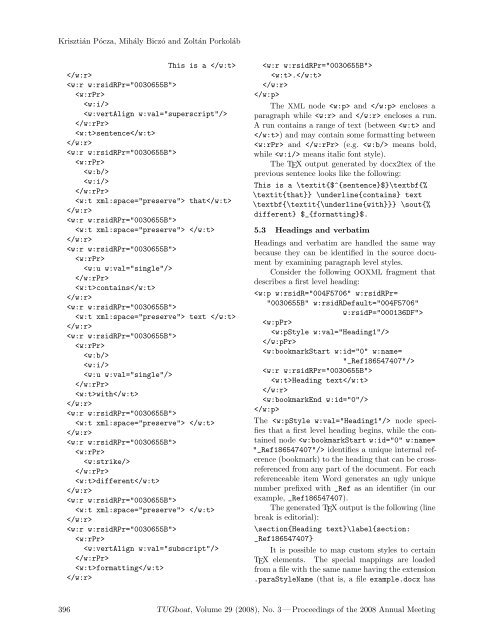The Communications of the TEX Users Group Volume 29 ... - TUG
The Communications of the TEX Users Group Volume 29 ... - TUG
The Communications of the TEX Users Group Volume 29 ... - TUG
Create successful ePaper yourself
Turn your PDF publications into a flip-book with our unique Google optimized e-Paper software.
Krisztián Pócza, Mihály Biczó and Zoltán Porkoláb<br />
This is a <br />
<br />
<br />
<br />
<br />
<br />
<br />
sentence<br />
<br />
<br />
<br />
<br />
<br />
<br />
that<br />
<br />
<br />
<br />
<br />
<br />
<br />
<br />
<br />
contains<br />
<br />
<br />
text <br />
<br />
<br />
<br />
<br />
<br />
<br />
<br />
with<br />
<br />
<br />
<br />
<br />
<br />
<br />
<br />
<br />
different<br />
<br />
<br />
<br />
<br />
<br />
<br />
<br />
<br />
formatting<br />
<br />
<br />
.<br />
<br />
<br />
<strong>The</strong> XML node and encloses a<br />
paragraph while and encloses a run.<br />
A run contains a range <strong>of</strong> text (between and<br />
) and may contain some formatting between<br />
and (e.g. means bold,<br />
while means italic font style).<br />
<strong>The</strong> <strong>TEX</strong> output generated by docx2tex <strong>of</strong> <strong>the</strong><br />
previous sentence looks like <strong>the</strong> following:<br />
This is a \textit{$^{sentence}$}\textbf{%<br />
\textit{that}} \underline{contains} text<br />
\textbf{\textit{\underline{with}}} \sout{%<br />
different} $_{formatting}$.<br />
5.3 Headings and verbatim<br />
Headings and verbatim are handled <strong>the</strong> same way<br />
because <strong>the</strong>y can be identified in <strong>the</strong> source document<br />
by examining paragraph level styles.<br />
Consider <strong>the</strong> following OOXML fragment that<br />
describes a first level heading:<br />
<br />
<br />
<br />
<br />
<br />
<br />
Heading text<br />
<br />
<br />
<br />
<strong>The</strong> node specifies<br />
that a first level heading begins, while <strong>the</strong> contained<br />
node identifies a unique internal reference<br />
(bookmark) to <strong>the</strong> heading that can be crossreferenced<br />
from any part <strong>of</strong> <strong>the</strong> document. For each<br />
referenceable item Word generates an ugly unique<br />
number prefixed with _Ref as an identifier (in our<br />
example, _Ref186547407).<br />
<strong>The</strong> generated <strong>TEX</strong> output is <strong>the</strong> following (line<br />
break is editorial):<br />
\section{Heading text}\label{section:<br />
_Ref186547407}<br />
It is possible to map custom styles to certain<br />
<strong>TEX</strong> elements. <strong>The</strong> special mappings are loaded<br />
from a file with <strong>the</strong> same name having <strong>the</strong> extension<br />
.paraStyleName (that is, a file example.docx has<br />
396 <strong>TUG</strong>boat, <strong>Volume</strong> <strong>29</strong> (2008), No. 3 — Proceedings <strong>of</strong> <strong>the</strong> 2008 Annual Meeting

















